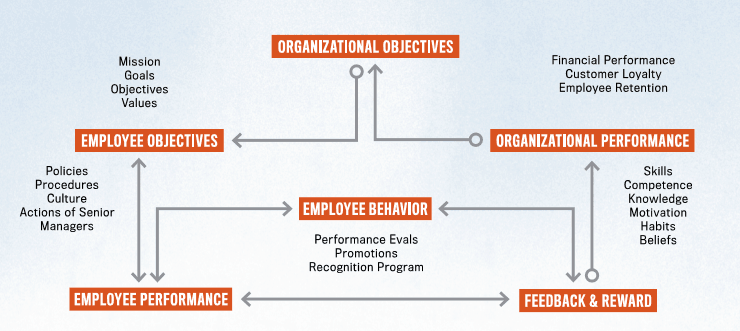 According to a recent survey by Leadership IQ,1 employees of all ages crave feedback now more than ever. Yet they aren’t getting it: 66% of respondents indicated they have too little interaction with their immediate supervisor, 67% reported that they don’t get enough positive feedback, and 51% said they don’t get enough constructive criticism. To make matters even worse, employees who don’t receive enough positive or constructive criticism indicated that they were 43% less likely to recommend their current employer.
According to a recent survey by Leadership IQ,1 employees of all ages crave feedback now more than ever. Yet they aren’t getting it: 66% of respondents indicated they have too little interaction with their immediate supervisor, 67% reported that they don’t get enough positive feedback, and 51% said they don’t get enough constructive criticism. To make matters even worse, employees who don’t receive enough positive or constructive criticism indicated that they were 43% less likely to recommend their current employer.
For managers at any level in an organization, lack of feedback can wreak havoc on the best-laid employee-retention plan. The results of a 2016 CareerBuilder study support the belief that employees have one eye on the door: 76% of full-time employed workers are either actively looking for or open to new job opportunities2 and a recent Jobvite Job Seeker Nation Study3 reported these job-change statistics:
- 35% of workers “change jobs at least every 5 years”
- 18% of workers “change jobs every 6–10 years”
- 47% of workers “stay [at their jobs] for more than 10 years”
For employers, all of this means that if you want your employees to stick around, you need to work hard to make them happy at your company. And making them happy means giving them the feedback they need.
Whoever first coined the saying “Employees join companies and leave managers” certainly hit the nail on the head—and this saying rings especially true in today’s job market. In fact, sometimes a company’s greatest business challenges arise not from competitors’ actions or customers’ needs but from within the company itself. If management or employees lack motivation, the quality of that company’s business plan or even of its product doesn’t matter. The key to that motivation—and to a company’s long-term success—is giving employees effective feedback. But what exactly is “effective feedback” by today’s standards?
Using Goal Setting to Motivate
It’s critical to understand the correlation between an employee’s defined goals and objectives and his or her actual performance.
Employee objectives should be derived directly from the organization’s objectives, and if the manager or employee can’t make a direct connection between the two, you need to ask if what the employee is working on truly benefits the company.
Establishing goals lays the groundwork for providing effective, actionable feedback. However, it’s important not just to define goals, but to define SMART goals:
- Specific: identifiable and observational
- Measurable: objective
- Achievable: moderately difficult, but realistic
- Relevant: meaningful to the individual, department, or organization
- Time-bound: completed within a specific time
Having a SMART goal ensures that the answer to “was the project done on time and correctly?” is either “yes” or “no.” This clear delineation allows for concrete feedback on an employee’s performance.
How you establish goals is just as important as setting them. Drafting and updating goals requires good communication between managers and employees. This communication can mean the difference between a worker who’s motivated and accountable and one who’s merely showing up and punching a clock. To create motivation, leaders need to define the expected results, then let their employees determine how to reach those goals. Giving employees a direct role in shaping their objectives strengthens their level of commitment much more than merely handing them a list of goals and sending them on their way.

Managers play a key role in their employees’ successes—and in their failures. To avoid the latter, managers must position their teams for success by empowering their members. Managers must be absolutely clear about their expectations and make sure that their teams have the support and resources they need to do the job well. (Conversely, managers can demotivate employees by giving orders and demanding action, by being ambiguous in their instructions, or by micromanaging their employees.)
Effective Feedback Starts with Effective Communication
Effective communication means taking responsibility for the whole communication cycle—being clear about expectations and ensuring that the employee understands what he or she is being asked to do.
It doesn’t stop there though as effective communication is two-way: the manager must also actively listen to an employee and pay attention to both the content (the “what”) and the intent (the “why”) of the message. To confirm understanding, managers should periodically summarize what they’ve heard, ask probing questions that can help identify any challenges employees may be facing in completing a task, and pay attention to nonverbal communication (the “how” of the message). And in all of these communications, managers need to be both empathetic and nonjudgmental.
When it is the manager’s turn to speak, he or she should be honest and not threatening. Remember, effective feedback isn’t about dishing out criticism; rather, it’s about identifying solutions to help employees achieve their tasks. Of course, an employee’s performance sometimes requires an “official” discussion that may kick off the process of termination. In day-to-day coaching efforts, however, it’s best to use feedback to generate a wider range of options to pursue while creating employee ownership and accountability.
Even more important, feedback must be both actionable and objective in order to establish clear expectations and outcomes. To accomplish this, feedback must
- be specific: It is based on objective firsthand experience and observation of job performance.
- identify the action or behavior: It constructively, clearly, and specifically describes the action or behavior for which feedback is being provided.
- be balanced: It reinforces positive behavior while not shying away from areas that need improvement, thus giving a complete picture of the employee’s performance.
- describe what did or didn’t work: It cites specific examples of how the individual was or was not completely effective in certain instances.
- not judge: It is observational, not judgmental. (For example, the statement “You clearly don’t care about your job, because you’re late all the time” passes judgment, whereas “You were late three days last week” is an observation.)
- be kind: It is not hostile or demeaning but truly concerned about the employee’s growth with the company.
- be in context: It clearly defines and focuses on only the project or aspect of an employee’s overall performance that needs improvement.
- suggest what should be done differently: It presents an alternative way of acting that would improve performance.
- provide an acceptable benefit: It pinpoints an area in which management and the employee believe that improvement would benefit the employee, his or her department, and the company.
- be followed up on: It tracks progress toward improvement. (After all, feedback without follow-up wastes everyone’s time because it demonstrates a lack of interest in addressing the problem.)
The Power of Coaching
There are many ways to provide feedback through coaching sessions. For example, some people want very structured feedback, whereas others prefer more intuitive feedback. Regardless of your particular style, however, effective coaching is about GROWing employees:
- Goal: Define the short-term goals of each coaching session and how they fit into the project’s long-term goals.
- Reality: Understand the current status of the project or objective and where employees stand in their ability to complete the task.
- Options: Empower employees to come up with other options or new possibilities that they may not have envisioned. (Managers may have to assist with this process, but the goal is to help employees come up with solutions on their own so that they are actively thinking of—and learning—new ways to approach problem solving.)
- Will: Determine what the employee will do next. (Lay out a plan with the new options.)
Final Thoughts on Employee Engagement and Effective Feedback
Effective feedback should not be a special event or a once-a-year activity (say, only during a company’s official performance review period). The most effective feedback happens all the time as employees accomplish projects normally and move on to the next ones.
Reinforcing positive behavior can result in more of the same (remember, you get what you reward!), and addressing issues helps ensure that bad behavior doesn’t become a habit. In addition, if you don’t address problems right away, frustration can build up until you, your managers, or your employees (or even all of you!) are ready to snap. Efforts to deal with performance issues at that point often come across as heated or personal rather than focused on actually fixing the situation.
The worst results arise when managers give no feedback at all. If an employee learns only during a yearly performance evaluation that he or she is not meeting expectations, then the manager has failed to provide effective feedback throughout the year. Clearly, it’s never too early to require your managers to give feedback. Don’t let good employees walk out your door and “leave managers” because they aren’t getting the feedback and manager interaction they need. Take the time now to build a great feedback program—before you’re stuck in a neverending recruiting cycle to make up for your managers’ bad behavior.
_________________
- Leadership IQ. 2009. “Managers Are Ignoring Their Employees.” Summary of survey of 3,611 workers in 291 organizations, mostly in the USA and Canada
- http://hiring.careerbuilder.com/promotions/candidatebehavior
- Jobvite. 2014. “2014 Jobvite Job Seeker Nation Study: An Authoritative Survey of the Social, Mobile Job Seeker.”
